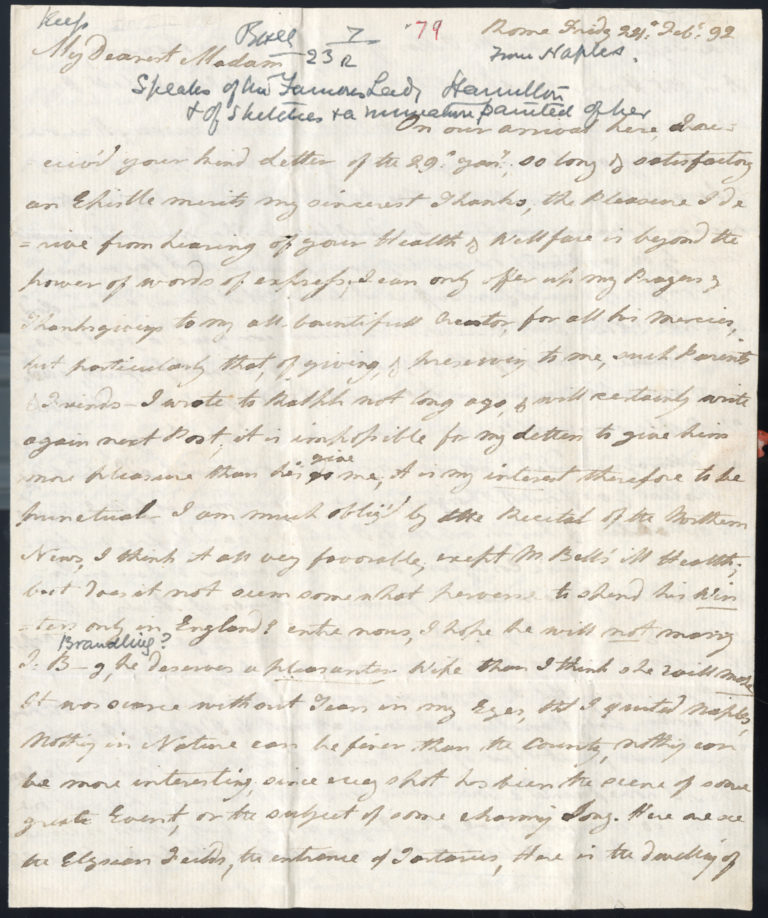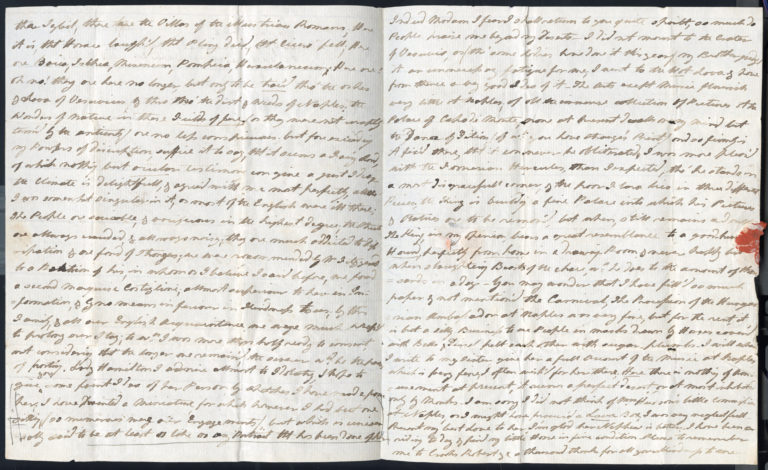Letter From Harriet Carr About Travelling And Visiting Mount Vesuvius, 1792
Reference: ZCE F/1/1/4/1
Topics: Portraiture, The Grand Tour, Travel Writing, Pompeii
LETTER FROM HARRIET CARR TO ISABELLA CARR
The letter is Harriet Carr’s reply to her mother, Isabella’s, letter of 29 January 1792. Harriet begins by responding to her mother’s ‘northern News’ of family and friends. Two local families are mentioned – the Bells and the Brandlings. M. Bell is likely to be Matthew Bell of Woolsington. The Brandling family lived at Gosforth.
Harriet is writing from Rome, Italy. She and her brother John have recently arrived there having previously been in Naples. Harriet gives an effusive description of the delights of Naples, its people, who she judges are ‘much affected to dissipation & are fond of strangers’, and the surrounding area calling it ‘a fairy land’. The letter was written during the early part of John and Harriet’s stay in Italy and Harriet’s enthusiasm may have been fired by the novelty of what she witnessed.
Almost all of Harriet’s Grand Tour letters include reference to her interest in art and her efforts to improve her own artistic knowledge and skills. Here she writes of sketching and painting Lady Hamilton. This is Emma Hamilton (1765-1815), model and actress who married Sir William Hamilton, the British Ambassador to Naples, and was to become the mistress of Lord Nelson. As the wife of the Ambassador to Naples, Emma Hamilton was at the heart of Neapolitan society. Harriet’s friendship with Emma Hamilton demonstrates the social circles that brother and sister were moving in. We also learn from the letter that John and Harriet were mixing with Italian society.
Harriet goes on to reflect on their stay in Naples. She describes visiting Mount Vesuvius reporting that she ‘…did not mount to the crater of Vesuvius, as (tho’ some Ladies have done it this year) my Brother judged it an unnecessary fatigue; I went to the Hot Lava & have from thence a very good Idea of it’. Vesuvius was a popular visitor destination from Naples. An eruption in AD 79 destroyed Roman cities including Herculaneum and Pompeii. In the 18th century Herculaneum and Pompeii were re-discovered and excavated leading to a huge public interest in the sites. Harriet appears to have been inspired by her visit to Vesuvius. The paintings that she brought home with her include two described as Herculaneum or Pompeian figures drawn about 1792. We know from this that Harriet was inspired not just by the galleries that she visited but also by some of the ancient sites she saw.
ADDITIONAL RESOURCES
Rome Frid[a]y 24th Feb[ruar]y [17]92
My Dearest Madam
On our arrival here, I receiv’d your kind Letter of the 29th Jan[uar]y, so long & satisfactory an Epistle merits my sincerest Thanks; the pleasure I derive from hearing of your Health & welfare is beyond the power of words of express(sic); I can only offer my Prayers & Thanksgiving to my all-bountifull Creator, for all his Mercies, but particularly that, of giving, & preserving to me, such Parents & Friends. I wrote to Ralph not long ago, & will certainly write again next Post; it is impossible for my Letters to give him more pleasure than his give me; it is my interest therefore to be punctual. I am much oblig’d by the Recital of the northern News, I think it all very favourable, except M Bell’s ill Health; but does it not seem somewhat perverse to spend his Winters only in England? entre nous, I hope he will not marry I. B[randlin]g, he deserves a pleasanter Wife than I think she will make[.] It was scarce without Tears in my Eyes, that I quited Naples, nothing in Nature can be finer than the Country, nothing can be more interesting, since every spot has been the scene of some great Event, or the subject of some charming Song. Here we see the Elysian Feilds, the entrance of Tartarus, Here is the dwelling of the Sybil, there are the Villas of the illustrious Romans, Here it is, that Horace laugh’d, that Pliny died, that Cicero fell; Here are Boica, Isthia, Mesenum, Pompeia, Herculaneum, Here are oh no! They are here no longer, but only to be trac’d thro’ the ashes of Lava of Vesuvius & thro [….] the dirt & weeds of Naples: the wonders of nature in these Fields of fire, (as they were not inaptly term’d by the antients,) are no less conspicuous; but far exceeding my powers of description, suffice it to say, that it seems a fairy Land of which nothing but ocular testimony can give a just Idea – the climate is delightfull, & agreed with me most perfectly, altho’ I was somewhat singular in it, as most of the English were ill there; The People are sociable, & vociferous in the highest degree; the streets are allways crowded, & allways noisy; they are much addicted to Dissipation & are fond of strangers; we were recommended by Mr Fitzgerald to a Relation of his, in whom as I believe I said before, we found a second Marquise Castiglioni, almost superior to her in Information, & by no means inferior in Kindness to us; by this Family, & all our English acquaintance, we were much press’d to prolong our Stay; to w[hi]ch I was more than half ready to consent, not considering that the longer we remain’d, the severer w[ou]ld be the pain of parting. Lady Hamilton I admire allmost to Idolatry, I hope to give you some faint idea of her person by sketches I have made from her; I have painted a miniature, for which however I had but one sitting, (so numerous were our Engagements), but which is universally said to be at least as like as any portrait that has been done of her. Indeed Madam I fear I shall return to you quite spoilt, so much do People praise me beyond my deserts. I did not mount to the crater of Vesuvius, as (tho’ some Ladies have done it this year) my Brother judged it an unnecessary fatigue; I went to the Hot Lava & have from thence a very good Idea of it. The Arts except Music flourish very little at napes; of all te immense collection of Pictures at the Palace of
Capo di Monte, none at present dwells on my mind but the Dance of Titian (of w[hi]ch you have Strange’s Print) and so firmly is it fix’d there, that it can never be obliterated. I was more pleas’d with the Farnesian Hercules, than I expected, tho’ he stands in a most disgraceful corner, & the poor Flora lies in three different Pieces; the King is building a fine Palace into which his
Pictures & Statues are to be remov’d, but when, still remains a doubt. The King, in my opinion, bears a great resemblance to a good hu[nting] Hound, perfectly from home in a drawing Room, & never happy but when slaughtering Beasts of the chase, w[hi]ch he does to the amount of thousands in a day. You may wonder that I have fill’d so much paper & not mention’d the Carnival, The Procession of the Hungarian Ambassador at Naples was very fine, but for the rest, it is but a silly Business to me People in masks drawn by Horses cover’d with Bells & Tinsel pelt each other with sugar plumbs. I will when I write to my sister, give her a full Account of the Music at Naples which is very fine, I often wish’d for her there; Here there is nothing of amusement at present, or I might have procur’d a Lava Box; I was very neglectfull. Present my best Love to her, I’m glad her Nephew is better. I have been a-riding today & find my little Horse in fine condition. Please to remember me to Crooks Roberts & a thousand thanks for all your Kindness to me. My affectionate Duty attends my Father & Love, [to] my Sister Believe me Dear Madam ever your affec[tiona]te Daughter H[arriet] Carr
My Brother sends his duty & Love he is busy or w[oul]d have written.
The Grand Tour and the Carr Family
Art Treasures in the North: Northern Families on the Grand Tour by Anne French (Unicorn Publishing Group, 2000)
John and Harriet Carr: A Brother and Sister from The North-East on The Grand Tour by Bill Purdue (Northern History, vol. 30, no. 1, 1994)
The British Abroad: The Grand Tour in the Eighteenth Century by Jeremy Black (The History Press, 1992)
Italy and the Grand Tour by Jeremy Black (Yale University Press, 2010)
Ladies of the Grand Tour by Brian Dolan (Flamingo, 2010)
Lady Emma Hamilton
Beloved Emma: The Life of Emma, Lady Hamilton by Flora Fraser (Bloomsbury, 2012)
England’s Mistress: The Infamous Life of Emma Hamilton by Kate Williams (Arrow, 2007)
Pompeii, Herculaneum, and Vesuvius
The Fires of Vesuvius: Pompeii Lost and Found by Mary Beard (Belknap Press, 2010)
Pompeii: Exploring a Roman Ghost Town by Ron and Nancy Goor (Cromwell, 1986)
Pompeii: A History of the City and the Eruption of Mount Vesuvius by Fergus Mason (BookCaps Study Guide, 2013)
Herculaneum: Italy’s Buried Treasure by Joseph Jay Deiss (Getty Publications, 2006)
Vesuvius: A Biography by Alwyn Scarth (Terra Publishing, 2009)
Vesuvius: The Most Famous Volcano in the World by Gillian Darley (Profile Books, 2011)





